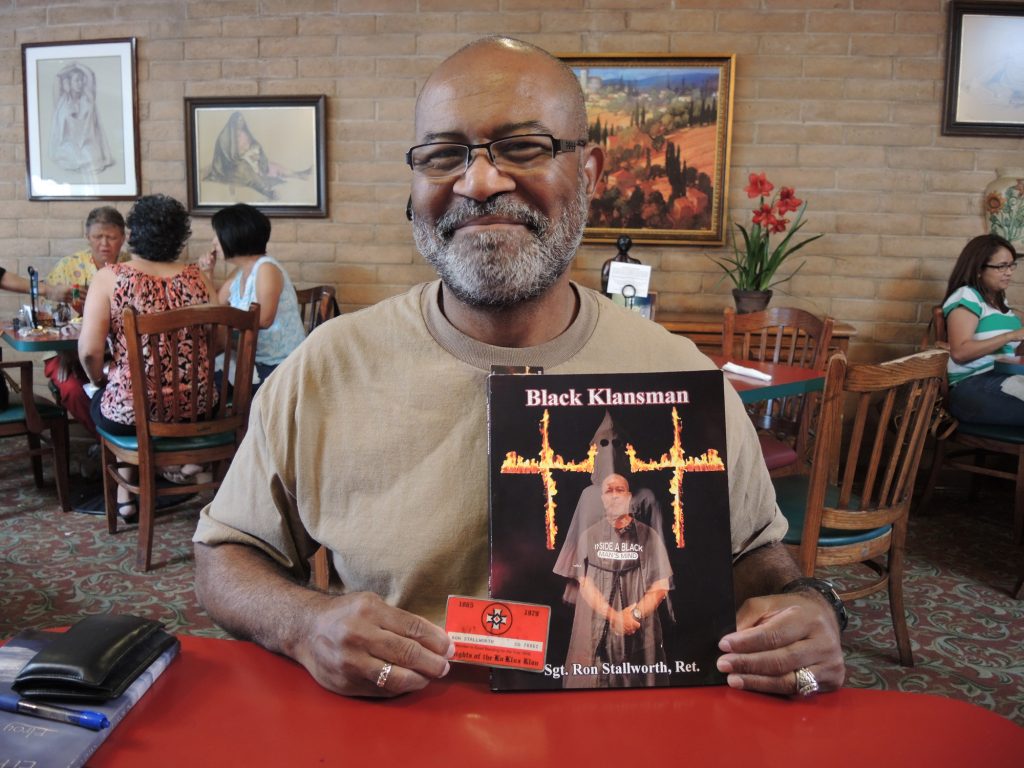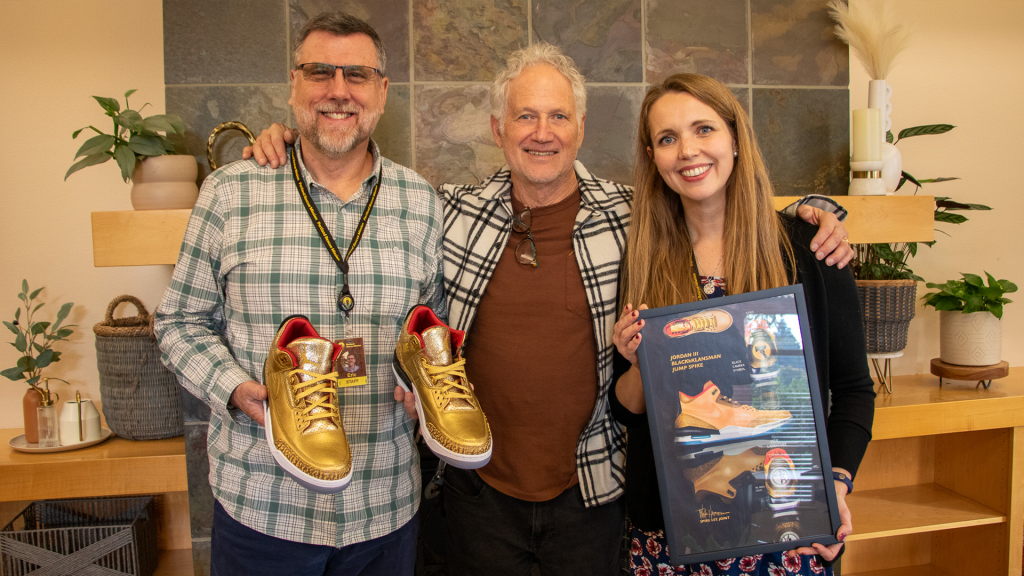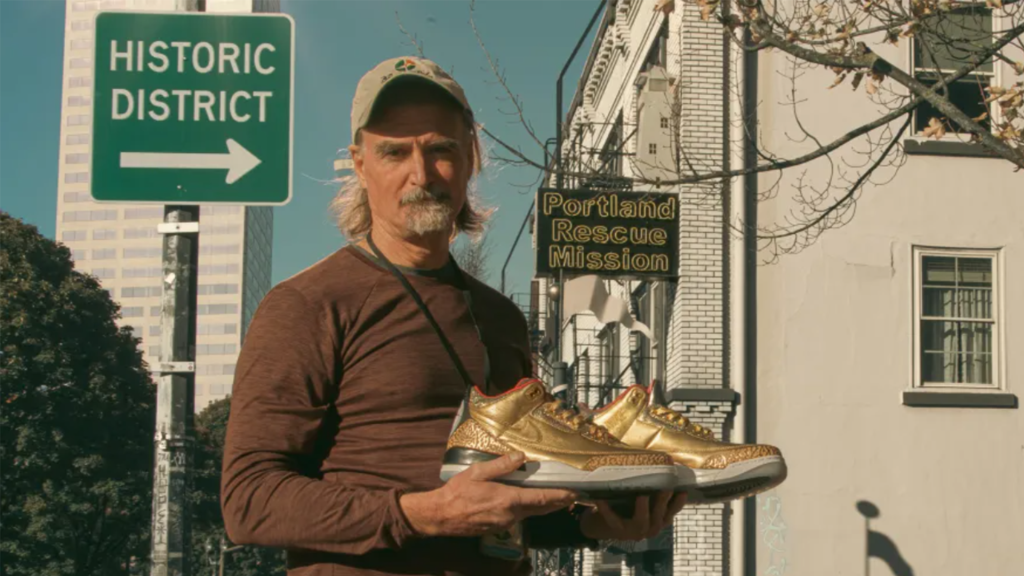In the liturgical calendar, on January 6 we mark Epiphany, which represents Christ appearing to the Gentiles through the visitation of the magi, the wise mystics from the east who brought gifts to the baby Jesus.
Recently, instead of precious oils like frankincense or myrrh, I’m imagining another precious gift: a pair of Nike Air Jordans.
I’ll explain later, but first consider another gift that we reference in light of the Christmas season—the gift of creativity. For those of us lacking financial means to purchase meaningful gifts for our loved ones, we tend to lean on creativity as a way to express our care and devotion. Katherine Davis’s holiday standard “The Carol of the Drum” (a.k.a. “The Little Drummer Boy”) has become a staple of holiday playlists everywhere, in part, because of the idea it promotes of each person bringing whatever skill or ability they have and offering it to Jesus.
The Apostle Paul, writing several decades after Jesus was born, exhorted members of the church in Colossae thusly: “Whatever you do, work at it with all your heart, as working for the Lord, not for human masters” (Colossians 3:23, NIV). In that chapter Paul encourages the believers to make life choices that will help set them apart as God’s chosen people. It’s not just about avoiding certain behaviors that might compromise their witness, but it’s also about affirming the new things that God is doing and putting their time and energy into joining God’s work. There’s an undercurrent of creativity that flows through all of it, from renewing of self (“put on the new self, which is being renewed in knowledge in the image of its Creator,” v. 10), to the metaphor of godly virtue as clothing (“clothe yourselves with compassion,” v. 12), and the references to music in verse 16. It’s discipleship through the lens of creativity.
As a creative person myself, I often wonder if the things I do really matter. It’s easy to look at a song that I wrote that has only 12 views on YouTube and wonder if it has any lasting eternal significance. I know that worshiping God is its own worthwhile pursuit, but I also see signs in some recent stories of people in various walks of life using their creativity, ingenuity, and God-given talent to make an immediate impact in their context. What each of them accomplished was impressive in its own right. But God used each one’s talent for even greater good in ways that reverberated long past their immediate contexts to create lasting, generational change.

First, I think of Ron Stallworth, who worked as a police detective in 1978. The first African American police officer in the Colorado Springs Police Department, Stallworth started by doing some research to uncover some intel on a local terrorist organization. As a result, he teamed up with a white coworker to begin a daring undercover investigation of that organization, the Ku Klux Klan. His exploits were captured in a 2014 memoir, Black Klansman.
Then I think of Deloris Jordan. In 1984, her cunning business acumen led her to advocate for her son, negotiating a portion of the revenue for every shoe sold by the company that was planning to put his name on it. That company, of course, was Nike; her son was Michael Jordan, and the shoe went on to become a generational touchstone, spawning an entire brand of iconic athletic apparel. In the 2023 Ben Affleck film Air depicting that negotiation, Deloris, played by Viola Davis, tells Matt Damon’s Sonny Vaccaro: “A shoe is just a shoe until my son steps into it.”

Which reminds me of Tinker Hatfield. Hatfield was a designer, and was quoted by author Jeremy Waite in his bite-sized inspirational book Ten Words, saying, “I don’t know if I have a legacy, but I will say that I’m proud of the fact that I’m from a small town in a small state and I’ve had more than a small impact.” That small town was Hillsboro, Oregon; Hatfield eventually attended the University of Oregon and worked as a designer at Nike, becoming the primary designer for the Air Jordan brand, which helped propel Nike from a scrappy upstart apparel company into a market-dominating behemoth.
Next, I think of Shelton Jackson Lee, the Oscar-winning filmmaker whose grandmother gave him the nickname “Spike” in high school. By 2019, Lee had long been critically acclaimed as a director who’d nabbed several Oscar nominations—the first of which came in 1990 for Do the Right Thing, a searing meditation on racial conflict in a simmering Brooklyn neighborhood. The nomination helped, of course, but Lee’s profile was already high in 1990 because of a series of ads he’d helmed for Nike for the Air Jordan shoe, featuring a character, Mars Blackmon, from his first feature, She’s Gotta Have It.

Finally, I think of a man named James Free. Free is in recovery from substance addiction, having lived years in Portland’s houseless community. He’s now pretty much back on his feet, and his recovery has been aided by his participation with the Portland Rescue Mission, which operates a warehouse on Portland’s west side that distributes clothing, toiletries, and other needed items to people in crisis. After going through a detox program, James elected to volunteer at the mission sorting donations.
During a recent shift, Free discovered something incredible in the donation bin: a pair of gold Air Jordan IIIs.
Any sneakerhead can tell you that the Jordan III is the most iconic of all the Air Jordan designs, because it was the first design by Hatfield, which featured Jordan’s distinctive Jumpman silhouette logo instead of the Nike swoosh. Hatfield’s design was, to use sports lingo, quite clutch. At the time, Michael Jordan was being courted by original Air Jordan designer Peter Moore and product manager Rob Strasser to leave Nike in favor of a new apparel company called Van Grack. But the Jumpman logo of the Jordan IIIs impressed Jordan enough to stay with Nike. The following year Jordan wore them during the NBA dunk contest, where he sailed through the air after taking off from the free-throw line, and the rest is history.

That’s why the Jordan IIIs were special. But these were gold Jordan IIIs, a colorway that Nike never produced during its initial run or in any major rerelease. In fact, those particular shoes were specially designed by Tinker Hatfield at the request of Spike Lee, who wore a pair and gave a few away to select guests who witnessed his first win at the Oscars. In 2019, Lee’s film adaptation of Stallworth’s 2014 memoir, BlacKkKlansman, won the Academy Award for Best Adapted Screenplay.
So that’s how they ended up at Portland Rescue Mission. Someone at Nike must’ve gotten ahold of the ultra-rare sneakers, and rather than keeping them for their personal collection, decided to donate them anonymously. When Free saw them in the donation bin, he knew they were special. He told his supervisor Erin Holcomb, who serves as director of staff ministries at PRM, about the shoes.
After talking with a few experts and her superiors, Holcomb made the decision to auction the shoes off at the prestigious auction house Sotheby’s. “In my seventeen years of working at the mission, this is the first time we’ve ever decided to resell a donation,” said Holcomb, when we spoke over the phone. As part of the authentication process, she reached out to Hatfield, who later donated a customized box and some other design paraphernalia, along with his official signature, to enhance their value at auction. In order for the shoes to be included in Sotheby’s luxury sneaker event, Holcomb had to travel to New York herself and personally escort them to the facility. A total of $50,800 was raised at the auction which was held in December, more than double the $20,000 that Sotheby’s was expecting.
Think about that. A cop, a mother, an apparel designer, a movie director, a nonprofit director, and a man in recovery all collaborated to raise a five-figure endowment for Portland Rescue Mission in a process that spanned hundreds of miles, three time zones, and almost 50 years. What if Ron Stallworth never joined the police department, or thought going undercover was too risky? What if Deloris Jordan encouraged her son to take the first deal on the table? What if Tinker Hatfield went to a different college out of state? And what if Spike Lee stuck with directing commercials because it was lucrative? Or what if that anonymous donor decided to keep the shoes for themselves?
Creativity is always a valuable resource, which is why corporations pay top dollars for it. But beautiful things happen when God harnesses our creativity for his redemptive purposes. Holcomb says those shoes are a great metaphor for the work they do at the mission: helping people rediscover themselves as incalculable treasures of humanity, despite having been discarded or overlooked by others. “I’m thrilled the shoes ended up here,” Hatfield told the Portland Rescue Mission staff. “It’s a happy ending to a really great project.”
So as we launch into a new year, unleash your creativity! And don’t get too preoccupied with its immediate impact since there’s no way to predict where, how, or for how long our creative works will echo and reverberate through the tapestry of time. What is important is that we stay prepared with a gospel of peace on our feet, ready to offer our creative gifts to Jesus. Whether it’s from parting with Air Jordans or parting the river Jordan, God is always moving, active, and working.














